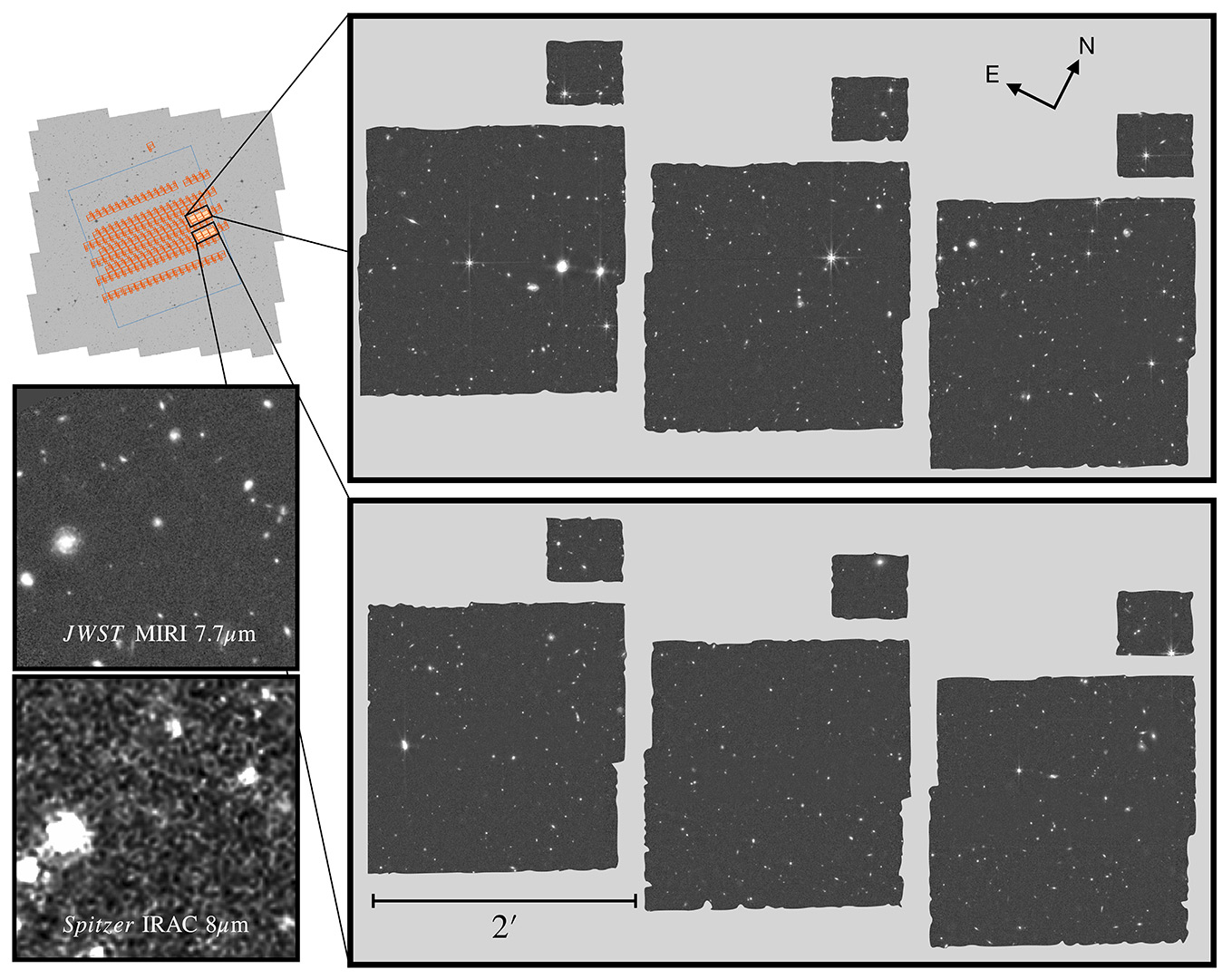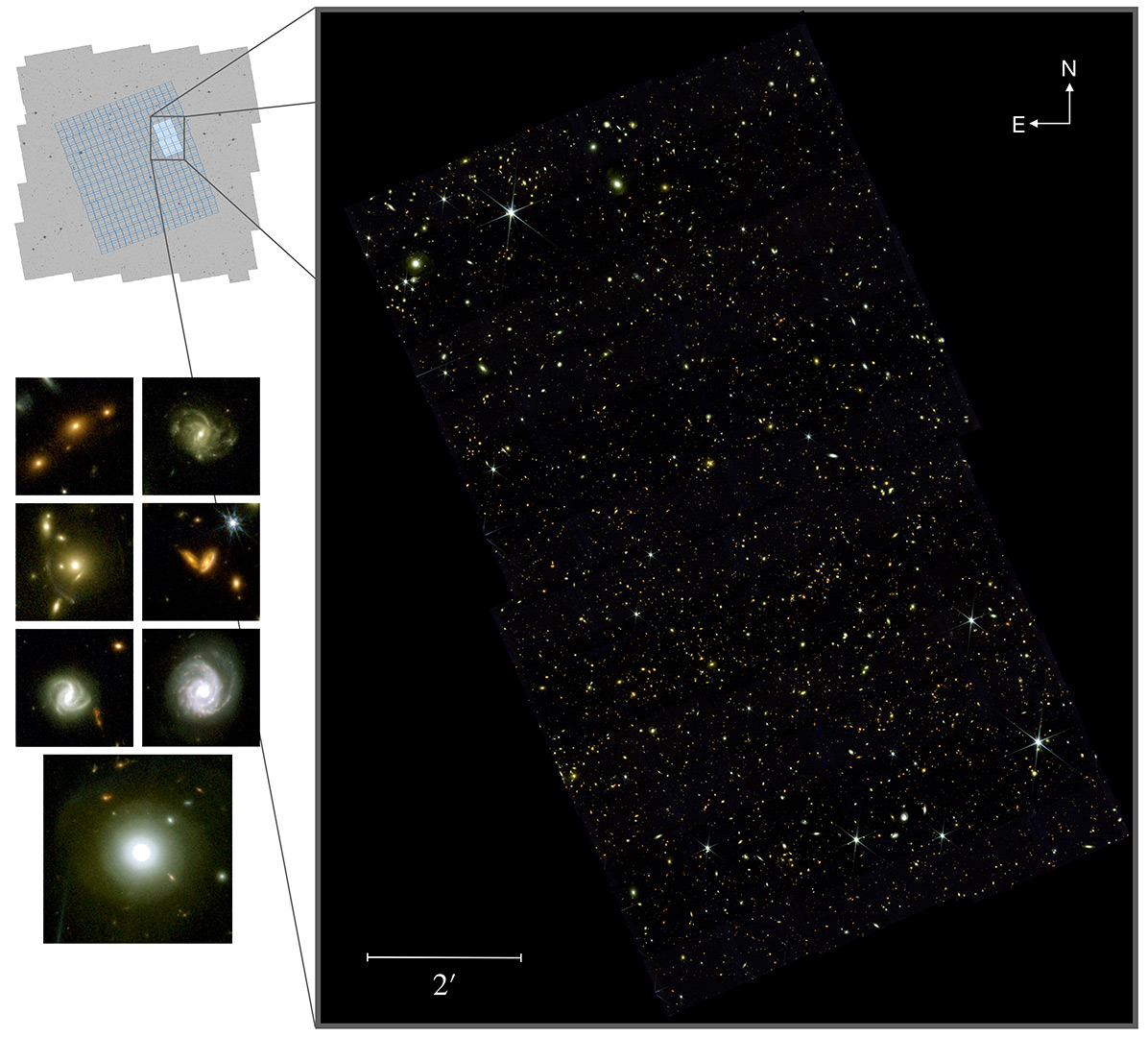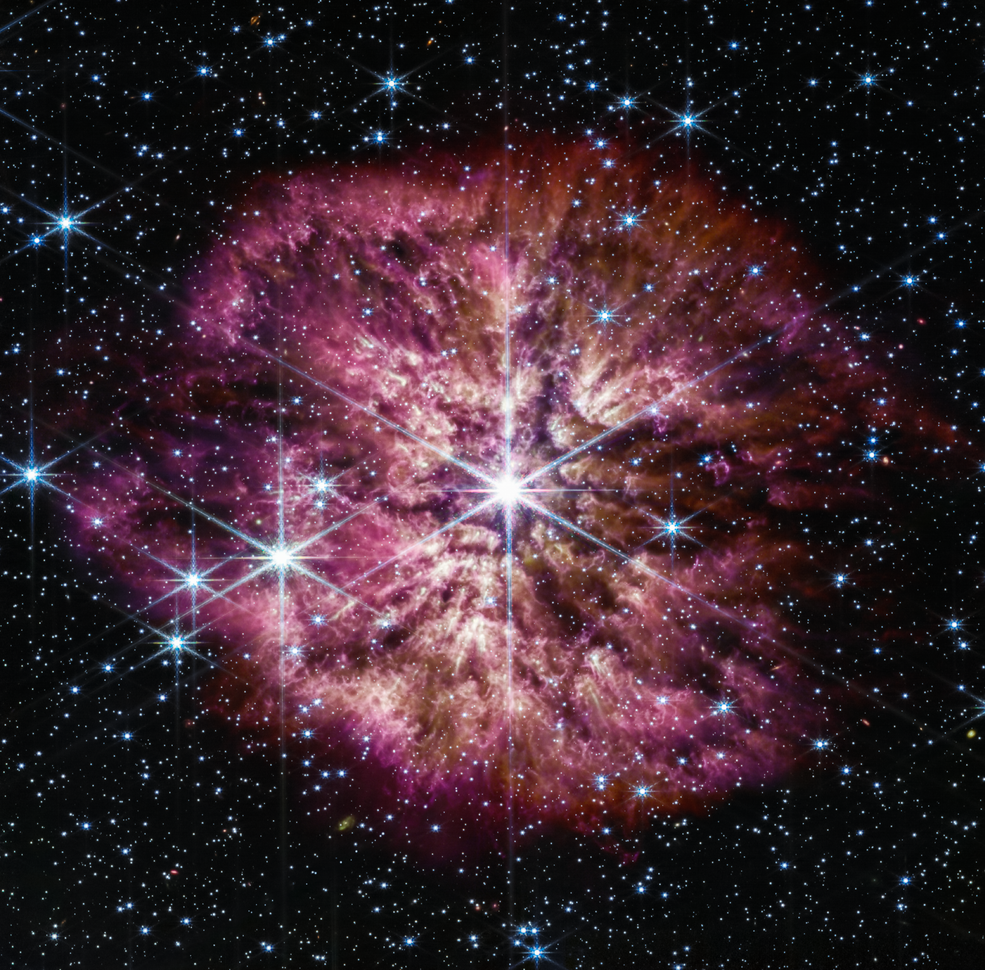17.02.2023
NASA’s Webb Uncovers New Details in Pandora’s Cluster

Astronomers have revealed the latest deep field image from NASA’s James Webb Space Telescope, featuring never-before-seen details in a region of space known as Pandora’s Cluster (Abell 2744). Webb’s view displays three clusters of galaxies – already massive – coming together to form a megacluster. The combined mass of the galaxy clusters creates a powerful gravitational lens, a natural magnification effect of gravity, allowing much more distant galaxies in the early universe to be observed by using the cluster like a magnifying glass.
Only Pandora’s central core has previously been studied in detail by NASA’s Hubble Space Telescope. By combining Webb’s powerful infrared instruments with a broad mosaic view of the region’s multiple areas of lensing, astronomers aimed to achieve a balance of breadth and depth that will open up a new frontier in the study of cosmology and galaxy evolution.
“The ancient myth of Pandora is about human curiosity and discoveries that delineate the past from the future, which I think is a fitting connection to the new realms of the universe Webb is opening up, including this deep-field image of Pandora’s Cluster,” said astronomer Rachel Bezanson of the University of Pittsburgh in Pennsylvania, co-principal investigator on the “Ultradeep NIRSpec and NIRCam ObserVations before the Epoch of Reionization” (UNCOVER) program to study the region.
“When the images of Pandora’s Cluster first came in from Webb, we were honestly a little star struck,” said Bezanson. “There was so much detail in the foreground cluster and so many distant lensed galaxies, I found myself getting lost in the image. Webb exceeded our expectations.” The new view of Pandora’s Cluster stitches four Webb snapshots together into one panoramic image, displaying roughly 50,000 sources of near-infrared light.
In addition to magnification, gravitational lensing distorts the appearance of distant galaxies, so they look very different than those in the foreground. The galaxy cluster “lens” is so massive that it warps the fabric of space itself, enough for light from distant galaxies that passes through that warped space to also take on a warped appearance.
Astronomer Ivo Labbe of the Swinburne University of Technology in Melbourne, Australia, co-principal investigator on the UNCOVER program, said that in the lensing core to the lower right in the Webb image, which has never been imaged by Hubble, Webb revealed hundreds of distant lensed galaxies that appear like faint arced lines in the image. Zooming in on the region reveals more and more of them.
“Pandora’s Cluster, as imaged by Webb, shows us a stronger, wider, deeper, better lens than we have ever seen before,” Labbe said. “My first reaction to the image was that it was so beautiful, it looked like a galaxy formation simulation. We had to remind ourselves that this was real data, and we are working in a new era of astronomy now.”
The UNCOVER team used Webb’s Near-Infrared Camera (NIRCam) to capture the cluster with exposures lasting 4-6 hours, for a total of about 30 hours of observing time. The next step is to meticulously go through the imaging data and select galaxies for follow-up observation with the Near-Infrared Spectrograph (NIRSpec), which will provide precise distance measurements, along with other detailed information about the lensed galaxies’ compositions, providing new insights into the early era of galaxy assembly and evolution. The UNCOVER team expects to make these NIRSpec observations in the summer of 2023.
In the meantime, all of the NIRCam photometric data has been publicly released so that other astronomers can become familiar with it and plan their own scientific studies with Webb’s rich datasets. “We are committed to helping the astronomy community make the best use of the fantastic resource we have in Webb,” said UNCOVER co-investigator Gabriel Brammer of the Niels Bohr Institute’s Cosmic Dawn Center at the University of Copenhagen. “This is just the beginning of all the amazing Webb science to come.”
The imaging mosaics and catalog of sources on Pandora’s Cluster (Abell 2744) provided by the UNCOVER team combine publicly available Hubble data with Webb photometry from three early observation programs: JWST-GO-2561, JWST-DD-ERS-1324, and JWST-DD-2756.
The James Webb Space Telescope is the world's premier space science observatory. Webb will solve mysteries in our solar system, look beyond to distant worlds around other stars, and probe the mysterious structures and origins of our universe and our place in it. Webb is an international program led by NASA with its partners, ESA (European Space Agency) and the Canadian Space Agency.
Quelle: NASA
----
Update: 18.02.2023
.
NASA’s Webb Reveals Intricate Networks of Gas and Dust in Nearby Galaxies

Researchers using NASA’s James Webb Space Telescope are getting their first look at star formation, gas, and dust in nearby galaxies with unprecedented resolution at infrared wavelengths. The data has enabled an initial collection of 21 research papers which provide new insight into how some of the smallest-scale processes in our universe – the beginnings of star formation – impact the evolution of the largest objects in our cosmos: galaxies.
The largest survey of nearby galaxies in Webb’s first year of science operations is being carried out by the Physics at High Angular resolution in Nearby Galaxies (PHANGS) collaboration, involving more than 100 researchers from around the globe. The Webb observations are led by Janice Lee, Gemini Observatory chief scientist at the National Science Foundation’s NOIRLab and affiliate astronomer at the University of Arizona in Tucson.
The team is studying a diverse sample of 19 spiral galaxies, and in Webb’s first few months of science operations, observations of five of those targets – M74, NGC 7496, IC 5332, NGC 1365, and NGC 1433 – have taken place. The results are already astounding astronomers.
“The clarity with which we are seeing the fine structure certainly caught us by surprise,” said team member David Thilker of Johns Hopkins University in Baltimore, Maryland.
“We are directly seeing how the energy from the formation of young stars affects the gas around them, and it’s just remarkable,” said team member Erik Rosolowsky of the University of Alberta, Canada.
The images from Webb’s Mid-Infrared Instrument (MIRI) reveal the presence of a network of highly structured features within these galaxies – glowing cavities of dust and huge cavernous bubbles of gas that line the spiral arms. In some regions of the nearby galaxies observed, this web of features appears built from both individual and overlapping shells and bubbles where young stars are releasing energy.
“Areas which are completely dark in Hubble imaging light up in exquisite detail in these new infrared images, allowing us to study how the dust in the interstellar medium has absorbed the light from forming stars and emitted it back out in the infrared, illuminating an intricate network of gas and dust,” said team member Karin Sandstrom of the University of California, San Diego.
The high-resolution imaging needed to study these structures has long evaded astronomers – until Webb came into the picture.
“The PHANGS team has spent years observing these galaxies at optical, radio, and ultraviolent wavelengths using NASA’s Hubble Space Telescope, the Atacama Large Millimeter/Submillimeter Array, and the Very Large Telescope’s Multi Unit Spectroscopic Explorer,” added team member Adam Leroy of the Ohio State University. “But, the earliest stages of a star’s lifecycle have remained out of view because the process is enshrouded within gas and dust clouds.”
Webb’s powerful infrared capabilities can pierce through the dust to connect the missing puzzle pieces.
For example, specific wavelengths observable by MIRI (7.7 and 11.3 microns) and Webb’s Near-Infrared Camera (3.3 microns) are sensitive to emission from polycyclic aromatic hydrocarbons, which play a critical role in the formation of stars and planets. These molecules were detected by Webb in the first observations by the PHANGS program.
Studying these interactions at the finest scale can help provide insights into the larger picture of how galaxies have evolved over time.
“Because these observations are taken as part of what's called a treasury program, they are available to the public as they are observed and received on Earth,” said Eva Schinnerer of the Max Planck Institute for Astronomy in Heidelberg, Germany, and leader of the PHANGS collaboration.
The PHANGS team will work to create and release data sets that align Webb’s data to each of the complementary data sets obtained previously from the other observatories, to help accelerate discovery by the broader astronomical community.
“Thanks to the telescope's resolution, for the first time we can conduct a complete census of star formation, and take inventories of the interstellar medium bubble structures in nearby galaxies beyond the Local Group,” Lee said. “That census will help us understand how star formation and its feedback imprint themselves on the interstellar medium, then give rise to the next generation of stars, or how it actually impedes the next generation of stars from being formed.”
The research by the PHANGS team is being conducted as part of General Observer program 2107. The team’s initial findings, comprised of 21 individual studies, were recently published in a special focus issue of The Astrophysical Journal Letters.
The James Webb Space Telescope is the world's premier space science observatory. Webb will solve mysteries in our solar system, look beyond to distant worlds around other stars, and probe the mysterious structures and origins of our universe and our place in it. Webb is an international program led by NASA with its partners, ESA (European Space Agency), and CSA (Canadian Space Agency).
Quelle: NASA
----
Update: 24.02.2023
,
James Webb telescope detects evidence of ancient ‘universe breaker’ galaxies
Huge systems appear to be far larger than was presumed possible so early after big bang, say scientists

The six candidate galaxies, based on observations by Nasa's James Webb space telescope.Photograph NASA
The James Webb space telescope has detected what appear to be six massive ancient galaxies, which astronomers are calling “universe breakers” because their existence could upend current theories of cosmology.
The objects date to a time when the universe was just 3% of its current age and are far larger than was presumed possible for galaxies so early after the big bang. If confirmed, the findings would call into question scientists’ understanding of how the earliest galaxies formed.
“These objects are way more massive than anyone expected,” said Joel Leja, an assistant professor of astronomy and astrophysics at Penn State University and a study co-author. “We expected only to find tiny, young, baby galaxies at this point in time, but we’ve discovered galaxies as mature as our own in what was previously understood to be the dawn of the universe.”
The observations come from the first dataset released from Nasa’s James Webb space telescope, which is equipped with infrared-sensing instruments capable of detecting light emitted by the most ancient stars and galaxies. While sifting through images, Dr Erica Nelson, of the University of Colorado Boulder, and a co-author, spotted a series of “fuzzy dots” that appeared unusually bright and unusually red.
Redness in astronomy is a proxy for age, because as light travels across the expanding universe it is stretched out, or red-shifted. These galaxies appeared to be roughly 13.5bn years old, placing them about 500m-700m years after the big bang.
These would not be the oldest galaxies observed by James Webb, which launched in December 2021. Last year, scientists spotted four galaxies that date to about 350m years after the big bang, but these were far smaller. Calculations suggest the latest galaxies harboured tens to hundreds of billions of sun-sized stars’ worth of mass, putting them on par with the Milky Way.
“It’s bananas,” said Nelson. “These galaxies should not have had time to form.”
Explaining the existence of such massive galaxies close to the dawn of time would require scientists to revisit either some basic rules of cosmology or the understanding of how the first galaxies were seeded from small clouds of stars and dust.
“It turns out we found something so unexpected it actually creates problems for science,” said Leja. “It calls the whole picture of early galaxy formation into question.”
Existing models suggest that after a period of rapid expansion, the universe spent a few hundred million years cooling down enough for gas to coalesce and collapse into the first stars and galaxies began to form, a period known as the dark ages.
“The discovery of such massive galaxies so soon after the big bang suggests that the dark ages may not have been so dark after all, and that the universe may have been awash with star formation far earlier than we thought,” said Dr Emma Chapman, an astrophysicist at the University of Nottingham, who was not involved in the latest observations.
Chapman said that further observations would be required to confirm the discovery before existing models could be abandoned. “Saying that, with the pace that JWST has been upturning theories and revolutionising whole fields, it wouldn’t surprise me if it were true!” she added.
The team are planning to obtain spectrum images, which can provide more accurate distance information and allow better estimates of mass. “A spectrum will immediately tell us whether or not these things are real,” Leja said.
Quelle: The Guardian
----
Update: 25.02.2023
.












